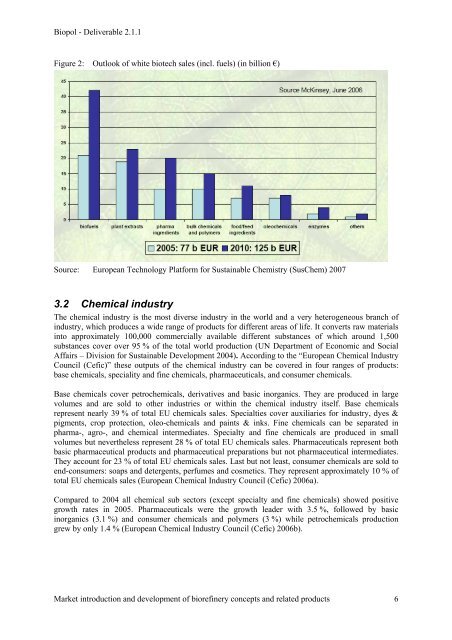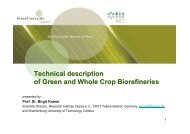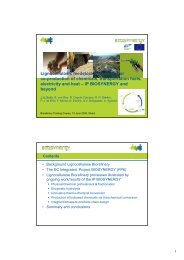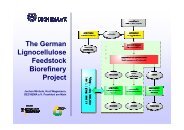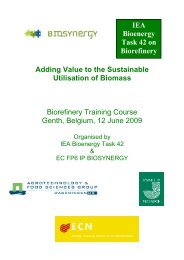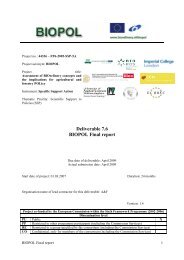D 2.1.1 Note on literature review concerning market ... - Biorefinery
D 2.1.1 Note on literature review concerning market ... - Biorefinery
D 2.1.1 Note on literature review concerning market ... - Biorefinery
Create successful ePaper yourself
Turn your PDF publications into a flip-book with our unique Google optimized e-Paper software.
Biopol - Deliverable <str<strong>on</strong>g>2.1.1</str<strong>on</strong>g><br />
Figure 2: Outlook of white biotech sales (incl. fuels) (in billi<strong>on</strong> €)<br />
Source: European Technology Platform for Sustainable Chemistry (SusChem) 2007<br />
3.2 Chemical industry<br />
The chemical industry is the most diverse industry in the world and a very heterogeneous branch of<br />
industry, which produces a wide range of products for different areas of life. It c<strong>on</strong>verts raw materials<br />
into approximately 100,000 commercially available different substances of which around 1,500<br />
substances cover over 95 % of the total world producti<strong>on</strong> (UN Department of Ec<strong>on</strong>omic and Social<br />
Affairs – Divisi<strong>on</strong> for Sustainable Development 2004). According to the “European Chemical Industry<br />
Council (Cefic)” these outputs of the chemical industry can be covered in four ranges of products:<br />
base chemicals, speciality and fine chemicals, pharmaceuticals, and c<strong>on</strong>sumer chemicals.<br />
Base chemicals cover petrochemicals, derivatives and basic inorganics. They are produced in large<br />
volumes and are sold to other industries or within the chemical industry itself. Base chemicals<br />
represent nearly 39 % of total EU chemicals sales. Specialties cover auxiliaries for industry, dyes &<br />
pigments, crop protecti<strong>on</strong>, oleo-chemicals and paints & inks. Fine chemicals can be separated in<br />
pharma-, agro-, and chemical intermediates. Specialty and fine chemicals are produced in small<br />
volumes but nevertheless represent 28 % of total EU chemicals sales. Pharmaceuticals represent both<br />
basic pharmaceutical products and pharmaceutical preparati<strong>on</strong>s but not pharmaceutical intermediates.<br />
They account for 23 % of total EU chemicals sales. Last but not least, c<strong>on</strong>sumer chemicals are sold to<br />
end-c<strong>on</strong>sumers: soaps and detergents, perfumes and cosmetics. They represent approximately 10 % of<br />
total EU chemicals sales (European Chemical Industry Council (Cefic) 2006a).<br />
Compared to 2004 all chemical sub sectors (except specialty and fine chemicals) showed positive<br />
growth rates in 2005. Pharmaceuticals were the growth leader with 3.5 %, followed by basic<br />
inorganics (3.1 %) and c<strong>on</strong>sumer chemicals and polymers (3 %) while petrochemicals producti<strong>on</strong><br />
grew by <strong>on</strong>ly 1.4 % (European Chemical Industry Council (Cefic) 2006b).<br />
Market introducti<strong>on</strong> and development of biorefinery c<strong>on</strong>cepts and related products<br />
6


